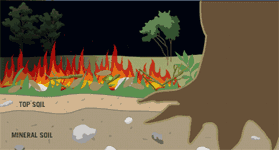Fire Ecology
Fires have always been an important ecosystem process throughout the Southeast region. Several natural communities are dependent on fire to remain healthy. These natural communities (such as scrub and pine flatwoods, and the many animal species that use them) depend on fire for their continued existence.
Fire is important for the survival of many plants and animals. For example, the gopher tortoise requires periodic fire to maintain its habitat quality. Some pine trees like the Ocala sand pine (Pinus clausa var. clausa) have cones that remain closed until fire sweeps through. Fire also promotes flower, seed, and fruit production in many plants, providing food for wildlife.
-
Fire As a Management Tool

Natural and prescribed fires reduce fuel build-up before it accumulates in large quantities - making wildfires less damaging. Fuel that is left to accumulate on the forest floor can result in an inferno. Fire actually restores and maintains natural habitat conditions in many ecosystems. For example, in the absence of fire, a pine flatwood would convert to a hardwood forest. Fire creates dramatic changes in the landscape, influences wildlife populations, and is the best wildfire insurance.
-
Fire and You
Today's challenge is balancing land management and public safety. Prescribed fire is a necessary and valuable tool but it also raises liability issues concerning smoke and the loss of structures in fire-prone areas. If you live near the edge of a forest, there are measures you can take to protect yourself and your home.
Additional Resources
- Fire in Florida
- FireWise
- Florida Division of Forestry
- Southern Center for Wildland-Urban Interface Research and Information
- Firewise Communities
- Firewise Landscaping
- Prescribed Fire | Florida Division of Forestry
- Anatomy of A Prescribed Burn
- The Natural Role of Fire



